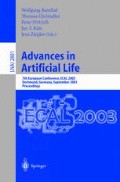Abstract
This paper describes an investigation of two computer models of how vowel systems can be transferred from one generation to the next. Humans tend to reduce the articulation of the vowels (and other speech sounds) they produce. If infants would learn on the basis of these reduced signals, vowel systems would collapse rapidly over time. As this is not observed in practice, some mechanism must be present to counter it. Two candidate mechanisms are investigated in this paper: compensatory expansion of articulations learned on the basis of reduced speech sounds and learning on the basis of more carefully articulated speech. It turns out that larger vowel systems with central vowels can only remain stable when learning is based on carefully articulated speech.
Access this chapter
Tax calculation will be finalised at checkout
Purchases are for personal use only
Preview
Unable to display preview. Download preview PDF.
References
de Boer, B.: Self-organization in vowel systems. Journal of Phonetics 28(4), 441–465 (2000)
Fernald, A.: Four month-old infants prefer to listen to motherese. Infant Behavior and Development 8, 181–195 (1985)
Fukunaga, K.: Introduction to statistical pattern recognition. Academic Press, Boston (1990)
Hock, H.H.: Principles of Historical Linguistics, 2nd edn. Mouton de Gruyter, Berlin (1991)
Kirby, S.: Function, Selection and Innateness: The emergence of language universals. Oxford University Press, Oxford (1999)
Kirby, S.: Natural Language from Artificial Life. Artificial Life 8, 185–215 (2002)
Kuhl, P.K., Andruski, J.E., Chistovich, I.A., Chistovich, L.A., Kozhevikova, E.V., Rysinka, V.L., Stolyarova, E.I., Sundberg, U., Lacerda, F.: Cross-Language Analysis of Phonetic Units in Language Addressed to Infants. Science 277, 684–686 (1997)
Labov, W.: Principles of Linguistic Change: internal factors. Blackwell, Oxford (1994)
Ladefoged, P., Maddieson, I.: The Sounds of the World’s Languages. Blackwell, Oxford (1996)
Liu, H.-M., Tsao, F.-M., Kuhl, P.K.: Support for an expanded vowel triangle in Mandarin motherese. International Journal of Psychology 35(3-4), 337 (2000)
Mantakas, M., Schwartz, J.L., Escudier Modèle de, P.: prédiction du ‘deuxiéme formant effectif’ F2’—application à l’étude de la labialité des voyelles avant du français. In: Proceesings of the 15th journées d’étude sur la parole. Société Française d’Acoustique, pp. 157–161 (1986)
Schwartz, J.-L., Boë, L.-J., Vallée, N., Abry, C.: The Dispersion-Focalization Theory of vowel systems. Journal of Phonetics 25, 255–286 (1997)
Steels, L.: A Self-Organizing Spatial Vocabulary. Artificial Life 2(3), 319–332 (1995)
Steels, L.: The Synthetic Modelling of Language Origins. Evolution of Communication 1(1), 1–34 (1997)
Vanvik, A.: A phonetic-phonemic analysis of Standard Eastern Norwegian. Norwegian Journal of Linguistics 26, 119–164 (1972)
Author information
Authors and Affiliations
Editor information
Editors and Affiliations
Rights and permissions
Copyright information
© 2003 Springer-Verlag Berlin Heidelberg
About this paper
Cite this paper
de Boer, B. (2003). Conditions for Stable Vowel Systems in a Population. In: Banzhaf, W., Ziegler, J., Christaller, T., Dittrich, P., Kim, J.T. (eds) Advances in Artificial Life. ECAL 2003. Lecture Notes in Computer Science(), vol 2801. Springer, Berlin, Heidelberg. https://doi.org/10.1007/978-3-540-39432-7_44
Download citation
DOI: https://doi.org/10.1007/978-3-540-39432-7_44
Publisher Name: Springer, Berlin, Heidelberg
Print ISBN: 978-3-540-20057-4
Online ISBN: 978-3-540-39432-7
eBook Packages: Springer Book Archive

